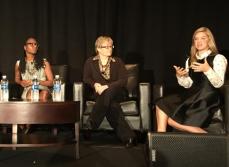How 5,000 students will go whale watching with biologists in real time

Some students in Hamilton, Montana have never seen, smelled or touched an ocean. But for one hour, they will have the chance to learn about Orcas and observe them in their natural habitat, in real time, interacting with experts speaking to them from two national parks in Washington state.
Later this month, roughly 5,000 students in 148 classrooms across Montana, Idaho, Washington, Oregon, Alaska and New Mexico will participate in a virtual, interactive program with naturalists in two national parks: Penrose Point and Lime Kiln Point. Another 2,000 students across the country will be able to watch the feed stream live. The program is provided free to participating schools; all they need are interactive whiteboards, computers or ideally, video teleconferencing equipment.
Journey to the Parks will allow students to see Orcas and other marine life in their natural habitats, take virtual tours of the parks, learn about Orca research and identification and why it’s important to study and understand whales. The students will engage with biologists who will be connected to their classrooms through a satellite-based mobile classroom provided by GCI, Alaska’s predominant telecommunications company.
“Obviously many students get to travel, but for those who don’t, this could be life-changing,” says Echo Allison, a K-5 enrichment specialist in Hamilton School District. “We are never going to be able to take a field trip to the coast, but for one hour we can explore tide pools and see Orcas,” she adds.
Allison, a veteran teacher of more than 20 years, says that distance learning technology has improved the quality of experiences she can provide her students. For example, edited documentaries provide information but pale in comparison to students’ being able to ask experts questions in the moment and interact with students from other states, says Allison.
“This kind of a virtual experience reflects a larger trend in how technology is opening up a world of possibilities in education,” said Pam Lloyd, vice president of GCI Education and GCI Healthcare. “Students in Alaska can share experiences and collaborate with students in Australia and visit places they might never get to experience virtually, like the Great Barrier Reef. Empowering students with this kind of technology will help prepare them for the global workforce of tomorrow.”
“This program brings science to life,” added Lloyd. “You are not going to get this kind of experience in the classroom.”
Participating teachers receive a detailed packet for pre-teaching lessons to build upon prior to the live event. The Washington Parks Foundation, in partnership with GCI, Polycom and VisionNet, funded the program, facilitated by Inspired Classroom, a distance learning company. The naturalists and educators are from Killer Whale Tales and Harbor WildWatch.
The virtual field trip makes use of a mobile classroom on a trailer that can broadcast audio, video and learning materials live from various locations via two-way video conferencing. The viewing screen can be split into sections to accommodate up to a five-way, multi-point call so remote classes can see and speak to each other and the expert at the park. During the hour, Inspired Classroom facilitates and acts as moderator for questions and answers.
Lloyd points out that since the 1990s, Alaska has been a leader in distance learning out of necessity; many students live in remote locations and attend tiny schools with very limited resources. GCI has partnered with Alaskan schools to bridge the gap to teaching and learning in an effort to establish equity, she says. And with ever-present funding challenges, Lloyd says her company is committed to connecting people and adding value beyond providing a technology or broadband service.
“Many of our students can’t leave their village or home but want to travel,” says Lloyd. Through distance learning they’ve connected to places around the world and even outer space, when students participated in a five-minute video conference with the space shuttle while in flight.
Moving forward, Lloyd says they’re exploring how to leverage distance learning to break down cultural barriers, with students creating original content that they can share with other students throughout the United States.
“Kids solving real world problems within our communities – wouldn’t that be powerful?” says Lloyd.




